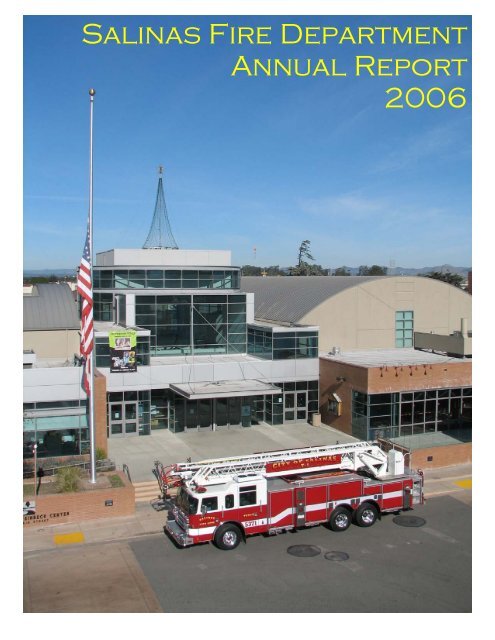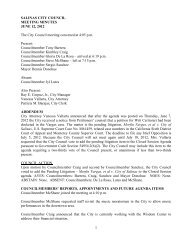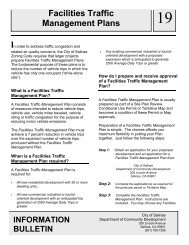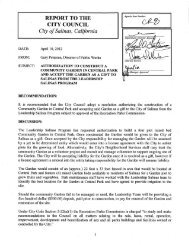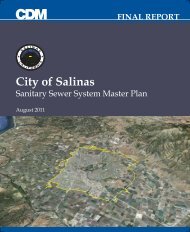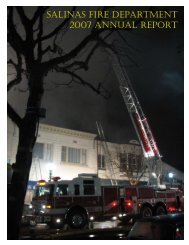Salinas Fire Department Annual Report 2006 - City of Salinas
Salinas Fire Department Annual Report 2006 - City of Salinas
Salinas Fire Department Annual Report 2006 - City of Salinas
Create successful ePaper yourself
Turn your PDF publications into a flip-book with our unique Google optimized e-Paper software.
<strong>Salinas</strong> <strong>Fire</strong> <strong>Department</strong><br />
<strong>Annual</strong> <strong>Report</strong><br />
<strong>2006</strong>
<strong>Salinas</strong> <strong>Fire</strong> <strong>Department</strong><br />
“Protecting lives, property, and the environment since 1874”<br />
Table <strong>of</strong> Contents<br />
Letter from the Chief 3<br />
Mission Statement, Values, and Guiding Principle 5<br />
Management Team 6<br />
<strong>Fire</strong> <strong>Department</strong> Personnel 8<br />
Organizational Chart 10<br />
Facilities 11<br />
<strong>Fire</strong> Station Locations 13<br />
Statistics 15<br />
Significant Incidents 21<br />
Incidents by Council District 24<br />
Emergency Medical Services 26<br />
Training 28<br />
<strong>Fire</strong> Prevention/Public Education 32<br />
Apparatus Inventory 36<br />
Search Dogs 37<br />
New Apparatus 38<br />
Conclusion 39<br />
<strong>Annual</strong> <strong>Report</strong> <strong>2006</strong><br />
- 2 -
<strong>Salinas</strong> <strong>Fire</strong> <strong>Department</strong><br />
“Protecting lives, property, and the environment since 1874”<br />
March 1, 2007<br />
Honorable Mayor, members <strong>of</strong> the <strong>Salinas</strong> <strong>City</strong> Council, and residents <strong>of</strong> the <strong>City</strong> <strong>of</strong> <strong>Salinas</strong>,<br />
On behalf <strong>of</strong> the men and women <strong>of</strong> the <strong>Salinas</strong> <strong>Fire</strong> <strong>Department</strong>, it is my pleasure to provide you with<br />
the <strong>Salinas</strong> <strong>Fire</strong> <strong>Department</strong> <strong>2006</strong> <strong>Annual</strong> <strong>Report</strong>. Contained in this document, you will learn about the<br />
personnel, facilities, equipment, and programs that serve you and our residents. I am sure that once you<br />
review this document, you will agree that the <strong>Salinas</strong> <strong>Fire</strong> <strong>Department</strong> is a highly trained and<br />
pr<strong>of</strong>essional organization, providing quality service based on the department’s core values <strong>of</strong> respect,<br />
trust, and support.<br />
We have accomplished many outstanding goals in <strong>2006</strong>. Acquisition <strong>of</strong> a new 105’ aerial ladder truck is<br />
the most visible accomplishment to the community. We received this unit in early December and it has<br />
since responded to numerous fires and calls for service inside our <strong>City</strong>. A well-trained ladder company<br />
plays a vital role in the stabilization <strong>of</strong> an incident. This unique piece <strong>of</strong> equipment, along with key<br />
personnel staffing it, has added a superb dynamic to our ability to protect lives and property.<br />
We have seen more lives saved in <strong>2006</strong> with our participation in the nationally recognized TimeMC 12-<br />
lead EKG Program. This program is funded by Duke University in partnership with Welch-Allyn, a<br />
leading medical equipment manufacturer. Our paramedics have the ability to confirm their evaluation <strong>of</strong><br />
potential cardiac patients, transmit this data via wireless connection to an on-call cardiologist, and have<br />
the patients into the cardiac catheterization laboratory in half the time <strong>of</strong> normal cardiac events. Our<br />
first successful transmission saw the patient in the hospital with the cardiologist in less than 20 minutes<br />
from the activation <strong>of</strong> 9-1-1. We are one <strong>of</strong> twelve nationwide EMS systems that are participating in<br />
this study. Glowing reports from Duke University place <strong>Salinas</strong> <strong>Fire</strong> above all other participants by a<br />
significant margin. This is due to the dedication <strong>of</strong> our crews to provide the best service possible.<br />
With the support <strong>of</strong> the Measure V Committee and the city council, we have begun the search for a <strong>Fire</strong><br />
Marshal. This position, which will be equivalent to the rank <strong>of</strong> Battalion Chief, will be responsible for<br />
overseeing the day-to-day operations <strong>of</strong> the <strong>Fire</strong> Prevention Bureau. One <strong>of</strong> the more important tasks<br />
this new position will have is the adoption <strong>of</strong> the latest edition <strong>of</strong> the California <strong>Fire</strong> Code and adapting<br />
it to the needs <strong>of</strong> our community. The <strong>Fire</strong> Marshal will be working with the building department,<br />
permit center, and city planners and be a highly visible representative <strong>of</strong> the fire department to the<br />
development and building community.<br />
In November <strong>of</strong> <strong>2006</strong>, the city council adopted the <strong>City</strong> <strong>of</strong> <strong>Salinas</strong> Multi-Hazard Functional Plan. This<br />
plan, required by the California Governor’s Office <strong>of</strong> Emergency Services and the Federal Emergency<br />
Management Agency, is our guidebook for the preparation, response, mitigation, and recovery phases <strong>of</strong><br />
a disaster. The newly appointed <strong>Fire</strong> Marshal, along with current members <strong>of</strong> the organization, will be<br />
responsible for maintaining and updating the plan as well as continued training <strong>of</strong> all city employees.<br />
The ongoing activities surrounding the plan will maintain open doors to disaster prevention and recovery<br />
funds from federal and state agencies.<br />
The Division <strong>of</strong> Training has been very active in bringing state certified classes to our organization.<br />
These have been <strong>of</strong>fered to both surrounding agencies and members <strong>of</strong> our own organization. In<br />
<strong>Annual</strong> <strong>Report</strong> <strong>2006</strong><br />
- 3 -
<strong>Salinas</strong> <strong>Fire</strong> <strong>Department</strong><br />
“Protecting lives, property, and the environment since 1874”<br />
addition, six new members <strong>of</strong> the department have attended hazardous materials technician training and<br />
are preparing to be added to the hazardous materials team.<br />
On January 1, <strong>2006</strong>, we began a modified partnership with Westmed Ambulance. The total revenue to<br />
be generated from this modified agreement totals $300,000. After renegotiation, the response time<br />
agreement remained in effect, however, the transport ambulance was eliminated, being replaced with the<br />
non-transport rescue vehicle. This reduced the revenue generation for the city to $25,000 per month. As<br />
we move into 2007, Westmed continues to have significant financial issues which could ultimately<br />
affect emergency medical services county-wide. <strong>Fire</strong> department staff has been working closely with<br />
the Monterey County Emergency Medical Services Agency to develop a contingency plan in the event<br />
Westmed can no longer fulfill their contractual obligation. <strong>City</strong> council and staff will, as always, be<br />
receiving regular updates from me regarding this issue.<br />
Though the Westmed partnership was a small bump in the road, overall <strong>2006</strong> was a stellar year for the<br />
<strong>Salinas</strong> <strong>Fire</strong> <strong>Department</strong>. We are anticipating the arrival <strong>of</strong> two structural firefighting engines and one<br />
wildland firefighting engine. In the spring <strong>of</strong> 2007 we will be facilitating promotional exams for<br />
battalion chief, captain, and engineer as well as a new firefighter recruitment. Continued enhancements<br />
in the training division will bring additional state certified classes as well as advanced rescue and<br />
hazardous materials training for all personnel. It will be an exciting and challenging year.<br />
As always, thank you for allowing me to serve this fine community.<br />
Yours in prevention, education, and protection,<br />
Edward R. Montez<br />
<strong>Fire</strong> Chief<br />
<strong>Annual</strong> <strong>Report</strong> <strong>2006</strong><br />
- 4 -
<strong>Salinas</strong> <strong>Fire</strong> <strong>Department</strong><br />
“Protecting lives, property, and the environment since 1874”<br />
Our Mission<br />
Dedicated to Our Residents and Our Pr<strong>of</strong>ession<br />
THE SALINAS FIRE DEPARTMENT is dedicated to the safety and well being <strong>of</strong><br />
our residents and our members. Our commitment is to provide this service by<br />
showing care and compassion to all those in need. We are determined to be a<br />
progressive, service-oriented organization that exhibits exceptional leadership.<br />
By working together we will become a recognized leader within the fire service<br />
and will participate, at all levels, in developing innovative concepts that advance<br />
our pr<strong>of</strong>ession and provide outstanding service to our residents.<br />
Our Values<br />
“Respect”<br />
“Trust”<br />
“Support”<br />
Our Guiding Principle<br />
“Leaders in Training, enhanced emergency medical services, and<br />
pr<strong>of</strong>essionalism”<br />
<strong>Annual</strong> <strong>Report</strong> <strong>2006</strong><br />
- 5 -
<strong>Salinas</strong> <strong>Fire</strong> <strong>Department</strong><br />
“Protecting lives, property, and the environment since 1874”<br />
Management Team<br />
Edward R. Montez, <strong>Fire</strong> Chief<br />
Chief Montez has been in the fire service for 34 years, starting his career with<br />
the Gilroy <strong>Fire</strong> <strong>Department</strong> in 1972. He came to <strong>Salinas</strong> <strong>Fire</strong> <strong>Department</strong> in<br />
1991 as Division Chief/<strong>Fire</strong> Marshal and was promoted to Deputy Chief in<br />
1993. In 1997 he accepted the position <strong>of</strong> <strong>Fire</strong> Chief with the Redwood <strong>City</strong><br />
<strong>Fire</strong> <strong>Department</strong> until his retirement in 2002. He came out <strong>of</strong> retirement in July<br />
2004 to become the 10 th chief <strong>of</strong> the <strong>Salinas</strong> <strong>Fire</strong> <strong>Department</strong>. Chief Montez<br />
has a Bachelor’s Degree in Management from St. Mary’s College <strong>of</strong> California.<br />
He holds numerous certifications in Prevention, Investigations, Suppression,<br />
and Command. He currently resides in <strong>Salinas</strong> with his wife Yvonne. They<br />
have two grown children, Miquel and Esteban.<br />
Jesse Pinon, Deputy <strong>Fire</strong> Chief<br />
Deputy Chief Pinon was born and raised in <strong>Salinas</strong> and started his fire service<br />
career as a volunteer firefighter in 1985 with the <strong>Salinas</strong> Rural <strong>Fire</strong> Protection<br />
District. He was hired by the <strong>Salinas</strong> <strong>Fire</strong> <strong>Department</strong> on January 19, 1987.<br />
He was promoted to Deputy <strong>Fire</strong> Chief on February 19, <strong>2006</strong>. Chief Pinon has<br />
an A.S. degree in <strong>Fire</strong> Protection from Monterey Peninsula College and is<br />
currently pursuing a Bachelor's Degree in <strong>Fire</strong> Administration from Cogswell<br />
Polytechnical College in Sunnyvale. He is also a state certified fire <strong>of</strong>ficer and<br />
chief <strong>of</strong>ficer. Jesse makes his home in <strong>Salinas</strong> with his wife Gloria. They<br />
have two grown children, Jesse Jr. and Michael.<br />
Scott Myhre, Battalion Chief – A Platoon<br />
Battalion Chief Myhre began his fire service career as a reserve firefighter<br />
with Santa Cruz <strong>Fire</strong> <strong>Department</strong>. After completing paramedic school in<br />
1989, he worked as a paramedic in Santa Cruz County until being hired by the<br />
<strong>Salinas</strong> <strong>Fire</strong> <strong>Department</strong> on July 25, 1995. He worked as a firefighterparamedic<br />
for <strong>Salinas</strong> until 1998 when he was promoted to the rank <strong>of</strong><br />
Administrative Captain placed in charge <strong>of</strong> the Emergency Medical Services<br />
program. In September 2005 he was promoted to the rank <strong>of</strong> Battalion Chief<br />
and placed in charge <strong>of</strong> A Platoon. His current responsibility in the<br />
organization is management <strong>of</strong> logistical support for the organization, which<br />
include buildings and grounds, supplies, and vehicle maintenance. Scott is a<br />
state certified fire <strong>of</strong>ficer and maintains his State Paramedic License. He lives in Sonora with his wife<br />
Pamela and they have three children Andrew (22), Patrick (19), and Caylie (12)<br />
<strong>Annual</strong> <strong>Report</strong> <strong>2006</strong><br />
- 6 -
<strong>Salinas</strong> <strong>Fire</strong> <strong>Department</strong><br />
“Protecting lives, property, and the environment since 1874”<br />
Brett D. Loomis, Battalion Chief – C Platoon<br />
Battalion Chief Loomis started his fire service career in 1990 as a volunteer<br />
firefighter with the Pacific Grove <strong>Fire</strong> <strong>Department</strong>. He was hired by the<br />
<strong>Salinas</strong> <strong>Fire</strong> <strong>Department</strong> on January 3, 1994. After his promotion to Captain<br />
in 1998, he spent two years as a Platoon Training Coordinator assigned to <strong>Fire</strong><br />
Station 3. He was promoted to Battalion Chief on December 2, 2005 and<br />
placed in charge <strong>of</strong> C Platoon where he oversees communications and<br />
information technology for the organization. Brett has a Bachelor <strong>of</strong> Science<br />
in <strong>Fire</strong> Administration from Cogswell College and will graduate in May 2007<br />
with a Master <strong>of</strong> Science in Public Administration from Golden Gate<br />
University. He is also a state certified fire <strong>of</strong>ficer, chief <strong>of</strong>ficer, and master<br />
instructor. Brett lives in Las Palmas Ranch with his wife Michelle and their two children, Max (age 8)<br />
and Julia (age 6).<br />
Sidney B. Turner, Battalion Chief – EMS & Training<br />
Battalion Chief Turner started in public safety as a deputy sheriff with<br />
Monterey County in 1980. He was hired by the <strong>Salinas</strong> <strong>Fire</strong> <strong>Department</strong><br />
March 4, 1985 and promptly attended paramedic school and has served the<br />
community as a paramedic ever since. He has served as a member <strong>of</strong> the<br />
Hazardous Materials Response Team and also dedicated several years to the<br />
training division as a Platoon Training Coordinator. He was promoted to<br />
Battalion Chief on December 28, 2005 and was put in charge <strong>of</strong> the Training<br />
and Emergency Medical Service divisions <strong>of</strong> the fire department. He is<br />
involved heavily in Home Land Security Operational Area as a direct Liaison<br />
to Office <strong>of</strong> Emergency Services. Chief Turner is also a member <strong>of</strong> the Office<br />
<strong>of</strong> Emergency Services emergency operations center management team. Chief Turner has attended<br />
Brigham Young University and is a state certified fire <strong>of</strong>ficer and hazardous materials specialist. Sid<br />
makes his home in San Benancio Canyon and has three grown children, Lance, Zach, and Eileen.<br />
Scott Tyler, Battalion Chief – B Platoon<br />
Battalion Chief Tyler has been with the <strong>Salinas</strong> <strong>Fire</strong> <strong>Department</strong> 29 years,<br />
starting as a fire cadet on April 24, 1978. He rose through the ranks in the<br />
organization, promoting to Battalion Chief on February 19, <strong>2006</strong>. Scott has<br />
also been a Platoon Training Coordinator and spent many years specializing<br />
in truck company operations at <strong>Fire</strong> Station 1. He is currently responsible for<br />
the hazardous materials program in the department as well as planning and<br />
mapping functions for the organization. Chief Tyler holds an Associate <strong>of</strong><br />
Science degree in <strong>Fire</strong> Protection Technology from Monterey Peninsula<br />
College and is a state certified fire <strong>of</strong>ficer and hazardous materials specialist<br />
and is fluent in Spanish. He makes his home in Pine Canyon with his two<br />
children, Logan and Aaron.<br />
<strong>Annual</strong> <strong>Report</strong> <strong>2006</strong><br />
- 7 -
<strong>Salinas</strong> <strong>Fire</strong> <strong>Department</strong><br />
“Protecting lives, property, and the environment since 1874”<br />
<strong>Fire</strong> <strong>Department</strong> Personnel<br />
<strong>Fire</strong> Captains<br />
Kenneth Logsdon<br />
Bruce Bush<br />
Rick Williams<br />
Tony Andrada<br />
Simon Jimenez<br />
Phil Vanderhorst<br />
Gina Aubrey<br />
Herb Shoemaker<br />
Ed Lauderdale<br />
Doug Dirksen<br />
Paul Fenwick<br />
Kevin Skinner<br />
Chris Vaughn<br />
Sam Klemek<br />
Hector Cortez<br />
Dan Green<br />
Andrew McLaughlin<br />
Mark Freedman<br />
Keith Emery<br />
Pat O’Connell<br />
Martin Flores<br />
John Wider<br />
<strong>Fire</strong> Engineers<br />
Frankie Rodriguez<br />
Barry Fitzgerald<br />
Gabriel Hernandez<br />
Ted Koch<br />
Randy Evans<br />
Humberto Carrillo<br />
Wilson Durham<br />
Gary Robinson<br />
Tom Luzod<br />
Michele Vaughn<br />
Tony Stagno<br />
David Hernandez<br />
Richard Lopez<br />
Rick Augustine<br />
Jesse Orozco<br />
Sierra Felker<br />
David Garibay<br />
Skylar Thornton<br />
Josh Hostetter<br />
Greg Hurst<br />
Shannon Bryant<br />
Jon Perkins<br />
<strong>Fire</strong>fighters<br />
Steve Furtado<br />
Bob Eggleston<br />
Trina Miguel<br />
Bob Flynn<br />
Scott McSeveney<br />
Joe Stagno<br />
Suzy Cottle-Gavalla<br />
John Bostwick<br />
Anna Woods<br />
Matt Evarts<br />
Robert Asamoto<br />
Dylan Bowman<br />
Scott Houchin<br />
Jonathan Barnes<br />
Jackie Pacelli<br />
Peter Robbert<br />
Mashaad Kiburi<br />
Cindy Yang<br />
Alfonso Meraz<br />
Cappy Pottorff<br />
Dara Herrick<br />
Carey Lesch<br />
Ernesto Valdez<br />
Jason Larsen<br />
Jason Victor<br />
Khadir Nijmeh<br />
Alejandro Limon<br />
Tawny Schoep<br />
Dennis Shea<br />
Paul White<br />
Tim Watson<br />
Shane VanderVeen<br />
Ben Majewski<br />
Kurtis Matthews<br />
Michael Mizer<br />
David Avila<br />
Arthur Leary<br />
David McPherson<br />
Alexander Marshall<br />
<strong>Annual</strong> <strong>Report</strong> <strong>2006</strong><br />
- 8 -
<strong>Salinas</strong> <strong>Fire</strong> <strong>Department</strong><br />
“Protecting lives, property, and the environment since 1874”<br />
<strong>Fire</strong> Inspectors<br />
Larry Steiber<br />
Rony Musones<br />
Mark Laine<br />
James Goulart<br />
Administrative Support<br />
Staff<br />
Cindy Robinson<br />
Mary Guevarra<br />
Retirements<br />
William Smart<br />
<strong>Fire</strong> Captain<br />
33 Years<br />
Hector Rodriguez<br />
<strong>Fire</strong> Captain<br />
25 Years<br />
Cheryl Smith<br />
<strong>Fire</strong> Captain<br />
18 Years<br />
Robert Riedinger<br />
<strong>Fire</strong>fighter/Mechanic<br />
25 years<br />
Separations<br />
Stephen Healy<br />
<strong>Fire</strong> Captain<br />
Bradford McHenry<br />
<strong>Fire</strong>fighter<br />
Promotions<br />
Jesse Pinon<br />
Deputy <strong>Fire</strong> Chief<br />
Scott Tyler<br />
Battalion Chief<br />
Patrick O’Connell<br />
<strong>Fire</strong> Captain<br />
Martin Flores<br />
<strong>Fire</strong> Captain<br />
John Wider<br />
<strong>Fire</strong> Captain<br />
Skylar Thornton<br />
<strong>Fire</strong> Engineer<br />
Josh Hostetter<br />
<strong>Fire</strong> Engineer<br />
Greg Hurst<br />
<strong>Fire</strong> Engineer<br />
Shannon Bryant<br />
<strong>Fire</strong> Engineer<br />
Jon Perkins<br />
<strong>Fire</strong> Engineer<br />
New Employees<br />
Tim Watson<br />
Shane VanderVeen<br />
Benjamin Majewski<br />
Kurtis Matthews<br />
Michael Mizer<br />
David Avila<br />
Arthur Leary<br />
David McPherson<br />
Alexander Marshall<br />
Appointments<br />
Jason Larsen<br />
<strong>Fire</strong>fighter/Mechanic<br />
Michele Vaughn<br />
HazMat Technician<br />
Josh Hostetter<br />
HazMat Technician<br />
Martin Flores<br />
HazMat Technician<br />
Search Dogs<br />
Comet<br />
(Engineer Michele Vaughn)<br />
Jeb<br />
(<strong>Fire</strong>fighter Jonathan Barnes)<br />
Trevor<br />
(Captain Kevin Skinner)<br />
<strong>2006</strong> <strong>Fire</strong>fighter <strong>of</strong> the Year<br />
Engineer Michele Vaughn<br />
<strong>Annual</strong> <strong>Report</strong> <strong>2006</strong><br />
- 9 -
<strong>Salinas</strong> <strong>Fire</strong> <strong>Department</strong><br />
“Protecting lives, property, and the environment since 1874”<br />
Organizational Chart<br />
Edward R. Montez<br />
<strong>Fire</strong> Chief/<strong>Fire</strong> Marshal<br />
Cindy Robinson<br />
Administrative Secretary<br />
Mary Guevarra<br />
Payroll Technician<br />
Jesse Pinon<br />
Deputy <strong>Fire</strong> Chief<br />
Larry Steiber<br />
Senior <strong>Fire</strong> Inspector<br />
<strong>Fire</strong> Inspectors<br />
Rony Musones<br />
Mark Laine<br />
James Goulart<br />
Scott Myhre<br />
Battalion Chief<br />
A Platoon<br />
Scott Tyler<br />
Battalion Chief<br />
B Platoon<br />
Brett Loomis<br />
Battalion Chief<br />
C Platoon<br />
Sid Turner<br />
Battalion Chief<br />
EMS/Training<br />
<strong>Fire</strong> Station 1<br />
Captain Bush<br />
Captain Skinner<br />
Captain Freedman<br />
<strong>Fire</strong> Station 2<br />
Captain McLaughlin<br />
<strong>Fire</strong> Station 3<br />
Captain Aubrey<br />
<strong>Fire</strong> Station 4<br />
Captain Andrada<br />
<strong>Fire</strong> Station 1<br />
Captain O’Connell<br />
A/Cp. Fitzgerald<br />
A/Cp. Durham<br />
<strong>Fire</strong> Station 2<br />
Captain Emery<br />
<strong>Fire</strong> Station 3<br />
Captain Lauderdale<br />
<strong>Fire</strong> Station 4<br />
Captain Dirksen<br />
<strong>Fire</strong> Station 1<br />
Captain Vaughn<br />
Captain Flores<br />
Captain Wider<br />
<strong>Fire</strong> Station 2<br />
Captain Fenwick<br />
<strong>Fire</strong> Station 3<br />
Captain Williams<br />
<strong>Fire</strong> Station 4<br />
Captain Jimenez<br />
Platoon Training<br />
Coordinators<br />
Captain Aubrey<br />
Captain Lauderdale<br />
Captain Williams<br />
Paramedics<br />
10 – Captains<br />
3 – Engineers<br />
12 – <strong>Fire</strong>fighters<br />
<strong>Fire</strong> Station 5<br />
Captain Klemek<br />
<strong>Fire</strong> Station 5<br />
Captain Green<br />
<strong>Fire</strong> Station 5<br />
Captain Logsdon<br />
<strong>Fire</strong> Station 6<br />
Captain Shoemaker<br />
<strong>Fire</strong> Station 6<br />
Captain Cortez<br />
<strong>Fire</strong> Station 6<br />
Captain Vanderhorst<br />
<strong>Annual</strong> <strong>Report</strong> <strong>2006</strong><br />
- 10 -
<strong>Salinas</strong> <strong>Fire</strong> <strong>Department</strong><br />
“Protecting lives, property, and the environment since 1874”<br />
<strong>Fire</strong> Station One, located at 216 West Alisal Street, was<br />
constructed in 1982. <strong>Fire</strong> Station One is the busiest fire<br />
station in the city, logging 2877 incidents in <strong>2006</strong>. The<br />
average response time to incidents in this district was 4<br />
minutes and 18 seconds. The daily minimum staffing at<br />
<strong>Fire</strong> Station One includes a three person engine company, a<br />
three person truck company, a two person paramedic rescue<br />
company, and the on duty battalion chief. Also available at<br />
this station is a reserve fire engine, a reserve ladder truck,<br />
and the hazardous materials response vehicle.<br />
<strong>Fire</strong> Station Two was opened in 1951 at 10 West Laurel<br />
Drive. Housing a three person paramedic engine company,<br />
<strong>Fire</strong> Station Two protects the north-central area <strong>of</strong> town.<br />
Incident reports in this district totaled 2261 in <strong>2006</strong> with an<br />
average response time <strong>of</strong> 4 minutes and 14 seconds. Also<br />
housed at <strong>Fire</strong> Station Two is one reserve fire engine.<br />
<strong>Fire</strong> Station Three is located at 827 Abbott Place. Home<br />
to the Division <strong>of</strong> Training, <strong>Fire</strong> Station Three was opened<br />
in 1957. Total calls occurring in <strong>Fire</strong> Station Three’s initial<br />
coverage area totaled 1137 for <strong>2006</strong>. These were answered<br />
with an average response time <strong>of</strong> 3 minutes and 40 seconds.<br />
Medic Engine 5313 is located at this station with a<br />
minimum staffing <strong>of</strong> three personnel daily. Brush Patrol<br />
5353 is also assigned to this station.<br />
<strong>Annual</strong> <strong>Report</strong> <strong>2006</strong><br />
- 11 -
<strong>Salinas</strong> <strong>Fire</strong> <strong>Department</strong><br />
“Protecting lives, property, and the environment since 1874”<br />
<strong>Fire</strong> Station Four, protecting the Alisal area <strong>of</strong> <strong>Salinas</strong>, was<br />
opened in 1966 at 308 Williams Road. <strong>Fire</strong> Station Four<br />
houses a paramedic engine company with a minimum<br />
staffing <strong>of</strong> three personnel. In calendar year <strong>2006</strong>, 1764<br />
calls for service were received in Station Four’s area. These<br />
calls were answered with an average response time <strong>of</strong> 3<br />
minutes and 56 seconds. Also housed at <strong>Fire</strong> Station 4 is<br />
Dry Chemical Unit 5350, which responds to all aircraft<br />
related emergencies in and around the airport.<br />
<strong>Fire</strong> Station Five was opened in June 2000 at 1400 Rider<br />
Avenue. A three person paramedic engine company staffs<br />
this fire station. The area protected by <strong>Fire</strong> Station Five<br />
generated 1053 incidents in <strong>2006</strong> which were answered with<br />
an average response time <strong>of</strong> 4 minutes and 32 seconds. Also<br />
located at this fire station is Brush Patrol 5355, Engine 1, a<br />
1917 American LaFrance antique fire engine and Engine 10,<br />
a 1972 Ward LaFrance fire engine that has been refurbished<br />
into a parade vehicle.<br />
<strong>Fire</strong> Station Six protects the Santa Rita and Harden Ranch<br />
residential areas from its location at 45 East Bolivar Street.<br />
In addition, this engine protects the Northridge Mall, Harden<br />
Ranch Shopping Center, and the <strong>Salinas</strong> Auto Mall. <strong>Fire</strong><br />
Station Six houses Paramedic Engine 5316 staffed with three<br />
personnel. Station Six’s response area received 1646 calls<br />
for service in <strong>2006</strong> with an average response time <strong>of</strong> 4<br />
minutes and 31 seconds.<br />
<strong>Salinas</strong> <strong>Fire</strong> <strong>Department</strong> Administration is located at 65 West Alisal Street, Suite 210. On the second<br />
floor <strong>of</strong> the permit center, <strong>Fire</strong> Administration has been in this facility since 1999. The Office <strong>of</strong> the<br />
<strong>Fire</strong> Chief is located here as well as the Deputy <strong>Fire</strong> Chief and the Battalion Chief in charge <strong>of</strong> EMS &<br />
Training. Located downstairs is the Bureau <strong>of</strong> <strong>Fire</strong> Prevention.<br />
<strong>Annual</strong> <strong>Report</strong> <strong>2006</strong><br />
- 12 -
<strong>Salinas</strong> <strong>Fire</strong> <strong>Department</strong><br />
“Protecting lives, property, and the environment since 1874”<br />
<strong>Annual</strong> <strong>Report</strong> <strong>2006</strong><br />
- 13 -
<strong>Salinas</strong> <strong>Fire</strong> <strong>Department</strong><br />
“Protecting lives, property, and the environment since 1874”<br />
<strong>Annual</strong> <strong>Report</strong> <strong>2006</strong><br />
- 14 -
<strong>Salinas</strong> <strong>Fire</strong> <strong>Department</strong><br />
“Protecting lives, property, and the environment since 1874”<br />
<strong>2006</strong> Response Statistics<br />
Calendar Year <strong>2006</strong> brought a significant growth in emergency responses to the <strong>Salinas</strong> <strong>Fire</strong><br />
<strong>Department</strong>. 10,741 emergency and non-emergency calls were answered by the men and women <strong>of</strong> the<br />
<strong>Salinas</strong> <strong>Fire</strong> <strong>Department</strong>. This is a 4.2% increase over calendar year 2005 which generated 10,309<br />
emergency calls. Analysis <strong>of</strong> the last five years response data indicated that an increase <strong>of</strong> 2.3% (10,546<br />
response) could have been expected for the <strong>2006</strong> calendar year. If we continue on an upward trend, the<br />
<strong>Salinas</strong> <strong>Fire</strong> <strong>Department</strong> can expect to answer approximately 10,850 calls for service in 2007.<br />
Five Year Response Totals<br />
10800<br />
10600<br />
10400<br />
10200<br />
10000<br />
Incidents<br />
9800<br />
9600<br />
9400<br />
9200<br />
9000<br />
9679<br />
10,741<br />
10,343<br />
10,010 10,309<br />
2002 2003 2004 2005 <strong>2006</strong><br />
Calendar Year<br />
There were 7,567 requests for emergency<br />
medical care in <strong>2006</strong>. This represents<br />
70.4% <strong>of</strong> all incidents in <strong>2006</strong>, an increase<br />
<strong>of</strong> 15.5% from the previous year (6,551<br />
EMS responses). This increase is due in<br />
part to implementation <strong>of</strong> new reporting<br />
criteria to allow the department to more<br />
accurately capture and process data. In this<br />
photo, members <strong>of</strong> Truck 5371 and<br />
Ambulance 5361 attend to the victim <strong>of</strong> a<br />
bicycle accident at Central Park.<br />
<strong>Annual</strong> <strong>Report</strong> <strong>2006</strong><br />
- 15 -
<strong>Salinas</strong> <strong>Fire</strong> <strong>Department</strong><br />
“Protecting lives, property, and the environment since 1874”<br />
<strong>Salinas</strong> <strong>Fire</strong> <strong>Department</strong> personnel responded<br />
to 1,027 traffic collisions in <strong>2006</strong>,<br />
representing 9.55% <strong>of</strong> all emergency medical<br />
related responses. These numbers include<br />
492 traffic collisions with injuries, 438 traffic<br />
collisions that were determined to be noninjury<br />
after the arrival <strong>of</strong> fire department<br />
personnel, and 97 vehicle versus pedestrian<br />
collisions. In this photo, Engineer Ted Koch<br />
works to stabilize the critically injured<br />
passenger <strong>of</strong> a vehicle that was struck<br />
broadside while attempting to turn across<br />
Highway 101 at Espinosa Road. The patient<br />
was airlifted to a bay area trauma center.<br />
DAILY CALL AVERAGE<br />
There was an average <strong>of</strong> 29.4 emergency<br />
calls per day in <strong>2006</strong>. This is a 1.2 call per<br />
day increase from the previous year.<br />
Incidents by Day <strong>of</strong> the<br />
Week<br />
Day <strong>of</strong> the<br />
Week<br />
Incidents<br />
% <strong>of</strong><br />
Total<br />
Calls<br />
Sunday 1610 15.0%<br />
Monday 1584 14.7%<br />
Tuesday 1484 13.8%<br />
Wednesday 1498 13.9%<br />
Thursday 1447 13.5%<br />
Friday 1615 15.0%<br />
Saturday 1518 14.1%<br />
<strong>2006</strong> Calls For<br />
Service by Hour<br />
0:00 313 2.91%<br />
1:00 280 2.60%<br />
2:00 235 2.18%<br />
3:00 199 1.85%<br />
4:00 173 1.61%<br />
5:00 195 1.81%<br />
6:00 243 2.26%<br />
7:00 344 3.20%<br />
8:00 450 4.18%<br />
9:00 513 4.77%<br />
10:00 530 4.93%<br />
11:00 630 5.86%<br />
12:00 582 5.41%<br />
13:00 611 5.68%<br />
14:00 578 5.37%<br />
15:00 653 6.07%<br />
16:00 630 5.86%<br />
17:00 644 5.99%<br />
18:00 606 5.63%<br />
19:00 556 5.17%<br />
20:00 515 4.79%<br />
21:00 477 4.43%<br />
22:00 420 3.90%<br />
23:00 379 3.52%<br />
<strong>Annual</strong> <strong>Report</strong> <strong>2006</strong><br />
- 16 -
<strong>Salinas</strong> <strong>Fire</strong> <strong>Department</strong><br />
“Protecting lives, property, and the environment since 1874”<br />
<strong>2006</strong> Incidents by Month<br />
Oct<br />
988<br />
Sep<br />
937<br />
Nov<br />
892<br />
Aug<br />
869<br />
Dec<br />
965<br />
Jul<br />
944<br />
Jan<br />
858 Feb<br />
803<br />
Jun<br />
921<br />
Mar<br />
877<br />
Apr<br />
815<br />
May<br />
872<br />
The incidents by month have remained relatively consistent over many years. Rarely does the fire<br />
department see a month when there are less than 800 incidents reported.<br />
Calls for Service by Incident Type<br />
FALSE<br />
HAZARD<br />
577<br />
347<br />
SERVICE<br />
1791<br />
EMS<br />
7567<br />
FIRE<br />
459<br />
0 1000 2000 3000 4000 5000 6000 7000 8000<br />
The average fire department response time to emergencies in the <strong>City</strong> <strong>of</strong> <strong>Salinas</strong> in <strong>2006</strong> was 4<br />
minutes and 11 seconds. This is a decrease <strong>of</strong> 10 seconds from 2005.<br />
<strong>Annual</strong> <strong>Report</strong> <strong>2006</strong><br />
- 17 -
<strong>Salinas</strong> <strong>Fire</strong> <strong>Department</strong><br />
“Protecting lives, property, and the environment since 1874”<br />
There were 80 vegetation fires responded to by<br />
<strong>Salinas</strong> firefighters in <strong>2006</strong>. Here, <strong>Fire</strong>fighter<br />
Scott McSeveney attacks a fire behind Steinbeck<br />
School. Rapid actions by the crew from Engine<br />
5315 kept this fire to ½ an acre with no property<br />
damaged or destroyed. The cause <strong>of</strong> the fire was<br />
use <strong>of</strong> illegal fireworks.<br />
Vehicle fires accounted for 95 <strong>of</strong> all fire incidents<br />
in <strong>2006</strong>. This fire, initially reported as a building<br />
fire, occurred on Front Street on October 6, <strong>2006</strong>.<br />
The Ford Expedition was fully involved upon the<br />
arrival <strong>of</strong> SFD companies and there were multiple<br />
explosions originating from the vehicle. An<br />
aggressive attack by Medic Engine 5312 and<br />
Engine 5311 brought the fire under control in 10<br />
minutes.<br />
There were 113 structure fires reported in <strong>2006</strong>.<br />
Estimated dollar loss from these fires totaled over<br />
$1.8 million. These fires also resulted in 9<br />
civilian injuries, two <strong>of</strong> which were life<br />
threatening. The photo on the left shows<br />
firefighters checking for fire extension into the<br />
attic <strong>of</strong> a duplex on Griffin Street. This late<br />
morning fire was controlled in 25 minutes. No<br />
occupants were home at the time <strong>of</strong> the incident.<br />
<strong>Annual</strong> <strong>Report</strong> <strong>2006</strong><br />
- 18 -
<strong>Salinas</strong> <strong>Fire</strong> <strong>Department</strong><br />
“Protecting lives, property, and the environment since 1874”<br />
<strong>2006</strong> Property Save/Loss Comparison<br />
$120,000,000<br />
$100,000,000<br />
$80,000,000<br />
$108,873,689<br />
$60,000,000<br />
$40,000,000<br />
$20,000,000<br />
$0<br />
Prop. Value<br />
$2,445,873<br />
Prop. Loss<br />
<strong>Fire</strong> incidents in the <strong>City</strong> <strong>of</strong> <strong>Salinas</strong> threatened over $108 million worth <strong>of</strong> property in <strong>2006</strong>. This graph<br />
demonstrates that the <strong>Salinas</strong> <strong>Fire</strong> <strong>Department</strong> helped to minimize damage to approximately $106<br />
million dollars <strong>of</strong> property that was threatened by fire.<br />
<strong>Salinas</strong> <strong>Fire</strong> <strong>Department</strong> personnel responded to 347<br />
hazardous condition and hazardous materials<br />
incidents in <strong>2006</strong>. This includes liquid fuel leaks<br />
from vehicles, chemical spills, and electrical<br />
hazards. One such incident, a liquid nitrogen leak,<br />
occurred in south <strong>Salinas</strong> at a produce packaging and<br />
distribution company. Captain Rick Williams and<br />
<strong>Fire</strong>fighter Alfonso Meraz attempt to secure the leak<br />
in this photo.<br />
There were 1791 service calls in <strong>2006</strong>. These<br />
included assisting invalid residents, smoke or odor<br />
investigations with no problem located, assisting law<br />
enforcement agencies, and water problems. In the<br />
water problem at right, a hit and run driver damaged<br />
the fire hydrant at the intersection <strong>of</strong> East Menke<br />
Street & Bridge Street. The crew from Engine 5311<br />
used fire hose and built earthen dams to direct the<br />
water away from the PG&E power switching<br />
building located less than 100 feet from the incident.<br />
It took California Water representatives over two<br />
hours to secure the leak.<br />
<strong>Annual</strong> <strong>Report</strong> <strong>2006</strong><br />
- 19 -
<strong>Salinas</strong> <strong>Fire</strong> <strong>Department</strong><br />
“Protecting lives, property, and the environment since 1874”<br />
<strong>2006</strong> <strong>Fire</strong>fighter Injury<br />
Statistics<br />
There were a total <strong>of</strong> 60 injuries reported by<br />
fire personnel.<br />
31 <strong>of</strong> these injuries required doctor evaluation<br />
and lost time.<br />
29 <strong>of</strong> these injuries were reported, however,<br />
the employee declined to seek medical care at<br />
the time <strong>of</strong> the injury.<br />
Two engines, a ladder truck, and a battalion<br />
chief were required to stabilize this building<br />
and extricate the driver from the vehicle.<br />
He was transported to the hospital with<br />
minor injuries.<br />
<strong>2006</strong> Total Apparatus Responses<br />
Support Units<br />
97<br />
Chief Officers<br />
367<br />
5361<br />
2302<br />
5371<br />
332<br />
5316<br />
1778<br />
5315<br />
1244<br />
5314<br />
1830<br />
5313<br />
1318<br />
5312<br />
2209<br />
5311<br />
1175<br />
0 500 1000 1500 2000 2500<br />
There were a total <strong>of</strong> 12,652 apparatus responses in <strong>2006</strong>. This is an increase <strong>of</strong> 634 apparatus<br />
responses compared to 2005.<br />
<strong>Annual</strong> <strong>Report</strong> <strong>2006</strong><br />
- 20 -
<strong>Salinas</strong> <strong>Fire</strong> <strong>Department</strong><br />
“Protecting lives, property, and the environment since 1874”<br />
<strong>2006</strong> Significant Incidents<br />
January<br />
Residential fire on Toyon Drive in North <strong>Salinas</strong> causes extensive damage to the home and displaces<br />
occupant. No injuries reported.<br />
March<br />
Suspected hazardous material at HSBC <strong>of</strong>fices on Schilling Place requires response <strong>of</strong> three SFD<br />
engines, ladder truck, hazardous materials teams from <strong>Salinas</strong>, Seaside, and the Monterey County<br />
Health <strong>Department</strong>, <strong>Salinas</strong> Police, Postal Inspectors, FBI, and Westmed Ambulance. 20 HSBC<br />
employees exposed to suspected material and transport to area hospitals for evaluation. Over seven<br />
hours required to bring the incident under control.<br />
June<br />
Two grass fires char over 8 acres in Natividad Creek Park and briefly threatened homes on<br />
Cottonwood Drive. Mutual aid from surrounding agencies was called in to assist. Both fires were<br />
deemed suspicious.<br />
July<br />
An apartment house fire on Del Monte Avenue causes heavy damage to two-story apartment and<br />
displaces several families.<br />
Within one hour <strong>of</strong> the first fire, a second apartment fire on West Rossi Street required mutual aid<br />
from three surrounding departments to assist SFD crews to bring the incident under control.<br />
September<br />
Residential structure fire on Seminole Way causes extensive damage to home and sends two<br />
firefighters to the hospital. Arson is suspected.<br />
On the same day, an ammonia leak from a packing facility in south <strong>Salinas</strong> cause the evacuation <strong>of</strong><br />
several businesses and injured one civilian. The leak was secured in approximately 30 minutes.<br />
December<br />
<strong>Fire</strong> in the basement <strong>of</strong> the Monterey County Courthouse caused exposure <strong>of</strong> SFD personnel to<br />
asbestos. Proper protective clothing prevented injury to SFD personnel. The four hour incident was<br />
handled by 17 firefighters and caused an estimated $50,000 in damaged to firefighting equipment.<br />
Cost recovery from the contractor was completed.<br />
On the same morning, a commercial structure fire on East Market Street heavily damaged a bridal<br />
shop. Rapid detection by <strong>Salinas</strong> Police Officers and a three minute response time for the first<br />
arriving engine allowed this fire to be controlled in less than 20 minutes.<br />
Carbon monoxide poisoning sickened seven people on Christmas Day, including four children. All<br />
patients transported to area hospitals in severe condition.<br />
<strong>Annual</strong> <strong>Report</strong> <strong>2006</strong><br />
- 21 -
<strong>Salinas</strong> <strong>Fire</strong> <strong>Department</strong><br />
“Protecting lives, property, and the environment since 1874”<br />
Overlapping Incidents<br />
There are eight staffed fire apparatus on duty every day in the <strong>City</strong> <strong>of</strong> <strong>Salinas</strong>; six engine companies, one<br />
truck company, and one paramedic rescue. The minimum staffing for this apparatus is 23 personnel per<br />
24 hour work day. As outlined earlier in this report, the average calls per day in the <strong>City</strong> <strong>of</strong> <strong>Salinas</strong> for<br />
calendar year <strong>2006</strong> was 29.4. With this number <strong>of</strong> calls every day, the occurrence <strong>of</strong> multiple calls<br />
simultaneously is reality. In <strong>2006</strong>, 39.3% <strong>of</strong> all incidents overlapped at least one other incident. The<br />
following is a summary <strong>of</strong> overlapping incidents in <strong>2006</strong>.<br />
Two Incidents<br />
Three Incidents<br />
Four Incidents<br />
Five Incidents<br />
Six Incidents<br />
Seven incidents or more<br />
3,625 times<br />
400 times<br />
108 times<br />
35 times<br />
26 times<br />
23 times<br />
When multiple incidents occur simultaneously, it is the responsibility <strong>of</strong> the on duty battalion chief to<br />
ensure that the city is adequately protected. Through the use <strong>of</strong> automatic and mutual aid agreements,<br />
resources from surrounding agencies are requested to come into the city and provide station coverage.<br />
This occurs approximately 100 times per year, primarily using resources from North Monterey County<br />
and <strong>Salinas</strong> Rural <strong>Fire</strong> Protection Districts.<br />
C Platoon firefighters use the “Jaws <strong>of</strong> Life” to remove the driver <strong>of</strong> this vehicle that rolled over<br />
multiple times on Highway 101 north <strong>of</strong> Main Street. The patient was airlifted to a San Jose trauma<br />
center in serious condition.<br />
<strong>Annual</strong> <strong>Report</strong> <strong>2006</strong><br />
- 22 -
<strong>Salinas</strong> <strong>Fire</strong> <strong>Department</strong><br />
“Protecting lives, property, and the environment since 1874”<br />
<strong>Annual</strong> <strong>Report</strong> <strong>2006</strong><br />
- 23 -
<strong>Salinas</strong> <strong>Fire</strong> <strong>Department</strong><br />
“Protecting lives, property, and the environment since 1874”<br />
Total Incidents by Council District<br />
1583<br />
814<br />
1159<br />
District 1<br />
Distrcit 2<br />
1797<br />
Distrcit 3<br />
District 4<br />
District 5<br />
3157<br />
District 6<br />
1571<br />
The crew from Medic Engine 5316 attacks a fully involved vehicle fire behind the<br />
Harden Ranch Shopping Center.<br />
<strong>Annual</strong> <strong>Report</strong> <strong>2006</strong><br />
- 24 -
<strong>Salinas</strong> <strong>Fire</strong> <strong>Department</strong><br />
“Protecting lives, property, and the environment since 1874”<br />
<strong>2006</strong> Incident Types by Council District<br />
District 6<br />
38<br />
52<br />
95<br />
216<br />
1183<br />
District 5<br />
80<br />
41<br />
64<br />
308<br />
1304<br />
District 4<br />
District 3<br />
39<br />
308<br />
43<br />
68<br />
247<br />
108<br />
129<br />
500<br />
1113<br />
2173<br />
False<br />
Service<br />
Hazard<br />
EMS<br />
<strong>Fire</strong><br />
Distrcit 2<br />
34<br />
49<br />
42<br />
202<br />
832<br />
District 1<br />
45<br />
116<br />
35<br />
63<br />
555<br />
0 500 1000 1500 2000 2500<br />
<strong>Annual</strong> <strong>Report</strong> <strong>2006</strong><br />
- 25 -
<strong>Salinas</strong> <strong>Fire</strong> <strong>Department</strong><br />
“Protecting lives, property, and the environment since 1874”<br />
Emergency Medical Services<br />
<strong>Annual</strong> <strong>Report</strong> <strong>2006</strong><br />
- 26 -<br />
Westmed Ambulance Partnership<br />
In January <strong>2006</strong>, the <strong>Salinas</strong> <strong>Fire</strong> <strong>Department</strong><br />
entered into a partnership with Westmed<br />
Ambulance. The goal was to enhance the level <strong>of</strong><br />
service to the <strong>City</strong> <strong>of</strong> <strong>Salinas</strong> and the County <strong>of</strong><br />
Monterey. One <strong>of</strong> the main components <strong>of</strong> the<br />
agreement included the fire department staffing a<br />
transport ambulance that, in the event <strong>of</strong> system<br />
demands, could be used to transport patients both<br />
inside and outside <strong>of</strong> the city limits. In addition,<br />
the transport time criterion for Westmed in the<br />
<strong>City</strong> <strong>of</strong> <strong>Salinas</strong> was lengthened from eight minutes<br />
to twelve minutes due to the fact that the <strong>City</strong> <strong>of</strong><br />
<strong>Salinas</strong> already provided paramedic services through the fire department. This agreement included<br />
payment from Westmed to the <strong>City</strong> <strong>of</strong> <strong>Salinas</strong> in the amount <strong>of</strong> $515,000 annually. This type <strong>of</strong><br />
partnership was unique to the County <strong>of</strong> Monterey but not unique to the fire service or emergency<br />
medical services pr<strong>of</strong>ession. It was the hopes <strong>of</strong> both agencies to make our partnership the model for<br />
other county agencies to follow.<br />
In November <strong>2006</strong>, the fire department was notified by Westmed that severe financial impacts were<br />
forcing changes to their service delivery. One <strong>of</strong> their plans for changes in service delivery was to end<br />
the partnership with the <strong>City</strong> <strong>of</strong> <strong>Salinas</strong>. After discussions, a renegotiation <strong>of</strong> the contract occurred. The<br />
new agreement included elimination <strong>of</strong> the transport ambulance. The response time criteria would<br />
remain in effect and the contract amount would be reduced to $25,000 per month.<br />
As <strong>2006</strong> came to a close, the financial hardship being faced by Westmed became more and more critical.<br />
Service levels countywide became an issue and emergency medical services in Monterey County<br />
quickly became “front page” news. What did not change was the dedication and drive <strong>of</strong> our<br />
paramedics and emergency medical technicians to continue to provide the highest levels <strong>of</strong> care<br />
possible. As the department enters 2007, EMS will continue to make headlines. The possibility <strong>of</strong><br />
changes to ambulance delivery services in Monterey County is a real possibility and <strong>Salinas</strong> <strong>Fire</strong><br />
<strong>Department</strong> will be playing a key role in the planning and implementation <strong>of</strong> such a plan.<br />
County Service Area 74 Funding<br />
At the close <strong>of</strong> 2005, the <strong>Salinas</strong> <strong>Fire</strong> <strong>Department</strong> was working with the Monterey County EMS Council<br />
and the Monterey County <strong>Fire</strong> Chiefs Association to develop a system for equitable distribution <strong>of</strong><br />
monies received by the county from County Service Area 74. Approved by voters in 1989, CSA 74<br />
assesses a $12 per parcel tax for paramedic services countywide. It is estimated that CSA 74 generates<br />
approximately $1.6 million annually.<br />
Continued negotiation with the Monterey County Board <strong>of</strong> Supervisors, the Monterey County Health<br />
<strong>Department</strong>, and the Monterey County Emergency Medical Services Agency has failed to reach
<strong>Salinas</strong> <strong>Fire</strong> <strong>Department</strong><br />
“Protecting lives, property, and the environment since 1874”<br />
amicable resolution to the issue <strong>of</strong> funding for local governments who provide emergency medical<br />
services. Though still a priority, this issue has taken a back seat to pressing EMS issues countywide. As<br />
the political climate settles surrounding Westmed the ability to provide emergency medical services to<br />
all <strong>of</strong> Monterey County, pursuit <strong>of</strong> CSA 74 funding and other funding mechanisms for EMS in the <strong>City</strong><br />
<strong>of</strong> <strong>Salinas</strong> will continue.<br />
Duke University/Time MC Study<br />
July 1, <strong>2006</strong> put the <strong>Salinas</strong> <strong>Fire</strong><br />
<strong>Department</strong> on the national stage for<br />
emergency medical services delivery.<br />
The Duke University/Time MC study is<br />
a program which puts 12-lead<br />
electrocardiogram monitoring at the<br />
paramedics fingertips. In response to a<br />
potential cardiac emergency, the<br />
paramedics have the ability to transmit<br />
their findings to an on-call cardiologist<br />
via wireless communications. If the<br />
cardiologist identifies a heart rhythm<br />
indicative <strong>of</strong> a myocardial infarction, the doctor can immediately speak to the paramedic on the phone,<br />
provide additional direction for patient care, and have the patient transported directly to the cardiac<br />
catheterization lab at <strong>Salinas</strong> Valley Memorial Healthcare System. This step <strong>of</strong> bypassing the<br />
emergency room and going straight to the cardiac lab drastically reduces the extent <strong>of</strong> damage caused by<br />
a heart attack and promotes a more rapid recovery for the patient.<br />
As one <strong>of</strong> only twelve agencies nationwide selected to participate in the program, <strong>Salinas</strong> has far<br />
exceeded the expectations <strong>of</strong> the program administrator at Duke University. In the six months since the<br />
study was initiated, <strong>Salinas</strong> has logged the highest number <strong>of</strong> successful transmissions and direct<br />
transports <strong>of</strong> any other participant. In one situation, the patient was in the cardiac catheterization lab in<br />
less than 20 minutes from the time 9-1-1 was activated. Permanent heart damage was prevented for that<br />
patient thanks to the rapid actions <strong>of</strong> fire<br />
department paramedics, doctors, and nurses<br />
who support this program.<br />
The study is scheduled to end on June 30,<br />
2007. However, due to the success <strong>of</strong> the<br />
program in <strong>Salinas</strong>, the fire department has<br />
elected to continue with the program.<br />
Working with <strong>Salinas</strong> Valley Memorial<br />
Healthcare System and the doctors from<br />
Central Coast Cardiology, we will continue<br />
to be leaders in emergency medical services<br />
while striving for the best patient care<br />
possible.<br />
<strong>Annual</strong> <strong>Report</strong> <strong>2006</strong><br />
- 27 -
<strong>Salinas</strong> <strong>Fire</strong> <strong>Department</strong><br />
“Protecting lives, property, and the environment since 1874”<br />
Training<br />
The Division <strong>of</strong> Training had another very dynamic year. Just a few <strong>of</strong> the accomplishments included a<br />
14-week recruit fire academy and hosting several California State <strong>Fire</strong> Marshal certified courses. In<br />
addition, 15 firefighters successfully completed their probationary final examinations, all occurring<br />
while the department had a record number <strong>of</strong> emergency responses and still maintaining a high level <strong>of</strong><br />
continuing training for existing staff.<br />
Recruit <strong>Fire</strong> Academy <strong>2006</strong><br />
Recruit Academy <strong>2006</strong> at the 9/11<br />
Remembrance Ceremony at <strong>City</strong> Hall.<br />
November 9, <strong>2006</strong> marked the graduation <strong>of</strong> yet<br />
another recruit fire academy for the <strong>Salinas</strong> <strong>Fire</strong><br />
<strong>Department</strong>. A new concept with this academy was<br />
to open it to civilians looking for training in the fire<br />
service. Two non-affiliated persons paid $1000 to<br />
participate in the 14-week state certified <strong>Fire</strong>fighter I<br />
academy. These two individuals, Elaney Karabetsos<br />
and Daniel Wallace, joined recruits Tim Watson,<br />
Shane VanderVeen, Benjamin Majewski, Kurtis<br />
Matthews, Michael Mizer, David Avila, Arthur<br />
Leary, David McPherson, and Alexander Marshall in<br />
learning about fire behavior and control,<br />
communications, fire streams, ladders, hose, forcible<br />
entry, search and rescue, ventilation, salvage, and<br />
overhaul techniques. In addition, these recruits<br />
received state certifications in hazardous materials first responder, Rescue Systems I, Saving Our Own,<br />
incident command system, and vehicle extrication. The total hours for the academy were 560 hours <strong>of</strong><br />
instruction. This equates to a total <strong>of</strong> 6,160 training hours for the 11 recruits.<br />
Facilitating this academy was Captain-Paramedic Gina Aubrey. Normally assigned to 24 hour shifts as<br />
a Platoon Training Coordinator, Captain Aubrey was placed on a 40-hour work assignment to oversee<br />
the academy and be the liaison between the fire<br />
recruits, the division <strong>of</strong> training, and the instructors.<br />
The department wishes to thank Captain Aubrey for<br />
her dedication to the academy and the training<br />
division.<br />
Instructing these recruits were a cadre <strong>of</strong> instructors;<br />
both <strong>Salinas</strong> <strong>Fire</strong> personnel and personnel from<br />
surrounding agencies. Nearly every member <strong>of</strong> the<br />
<strong>Salinas</strong> <strong>Fire</strong> <strong>Department</strong> addressed and/or instructed<br />
the recruits at some point during the academy.<br />
Whether as a primary instructor, an assistant<br />
instructor, or as support on the training grounds,<br />
every member <strong>of</strong> the department played a key role in<br />
the success <strong>of</strong> this academy. The rule <strong>of</strong> thumb for<br />
Recruits practice with portable master<br />
streams and foam at “the tower.”<br />
<strong>Annual</strong> <strong>Report</strong> <strong>2006</strong><br />
- 28 -
<strong>Salinas</strong> <strong>Fire</strong> <strong>Department</strong><br />
“Protecting lives, property, and the environment since 1874”<br />
instructional preparation is five hours <strong>of</strong> prep for<br />
every one hour <strong>of</strong> instruction. This equates to nearly<br />
2800 hours <strong>of</strong> preparation for instruction in the<br />
academy. This time includes building <strong>of</strong> props,<br />
creation <strong>of</strong> lesson plans, creation <strong>of</strong> PowerPoint<br />
presentations, and creation <strong>of</strong> tests and quizzes. These<br />
numbers demonstrate a dedication to training at all<br />
levels.<br />
<strong>Fire</strong> Recruit Shane VanderVeen practices<br />
rappelling during Rescue Systems I.<br />
A fire service tradition, ‘The Waterball Fight” teaches recruits the art <strong>of</strong> nozzle control, teamwork,<br />
and advancing hoselines while reminding them that laughing with each other is a good thing.<br />
<strong>Annual</strong> <strong>Report</strong> <strong>2006</strong><br />
- 29 -
<strong>Salinas</strong> <strong>Fire</strong> <strong>Department</strong><br />
“Protecting lives, property, and the environment since 1874”<br />
Hazardous Materials Training<br />
Successful grant applications through the <strong>Department</strong> <strong>of</strong> Homeland Security enabled the department to<br />
send six personnel to Hazardous Materials Technician Training. This 160 hour course trains personnel<br />
in the areas <strong>of</strong> chemical identification and analysis, hazardous materials mitigation and cleanup, and<br />
decontamination <strong>of</strong> hazardous materials locations. The employees who were sent to the training were<br />
Captain Martin Flores, Engineer Michele Vaughn, Engineer Josh Hostetter, Engineer Greg Hurst,<br />
Engineer Jon Perkins, and <strong>Fire</strong>fighter-Paramedic Dylan Bowman. All costs associated with the training,<br />
including back fill costs, were reimbursed to the <strong>City</strong> through the grant.<br />
stage for additional funding from state and federal grants<br />
to increase the preparedness <strong>of</strong> Monterey County<br />
agencies to respond to an event <strong>of</strong> such magnitude.<br />
Ongoing Company Training<br />
Continued training to keep skills sharp is always a high<br />
priority. <strong>Salinas</strong> <strong>Fire</strong> <strong>Department</strong> crews logged over<br />
32,000 hours <strong>of</strong> training in <strong>2006</strong>. This is approximately<br />
335 ½ hours per firefighter. These hours include state<br />
and federally mandated training hours for emergency<br />
medical services, hazardous materials, confined space<br />
rescue, and workplace safety training. Numerous hours<br />
were logged by employees who attended training<br />
sponsored by other agencies, taking advantage <strong>of</strong> tuition<br />
reimbursement available from the city. Over 50% <strong>of</strong> our<br />
employees have sought outside training opportunities,<br />
bringing new techniques back to the organization.<br />
<strong>Fire</strong> and EMS Instructors<br />
The hazardous materials team participated in several<br />
local training events including a joint response<br />
scenario with the Monterey County Urban Search and<br />
Rescue Team as well as the 72-hour drill at the<br />
Presidio <strong>of</strong> Monterey (Fort Ord) annex.<br />
Representatives from local, state, and national law<br />
enforcement, fire, ambulance, and <strong>of</strong>fice <strong>of</strong><br />
emergency services joined as this event to conduct a<br />
preparation evaluation drill to determine the state <strong>of</strong><br />
readiness for all responders in the event <strong>of</strong> a Weapons<br />
<strong>of</strong> Mass Destruction event. Deemed an<br />
overwhelming success, this drill helped to set the<br />
<strong>Salinas</strong> is the largest city between San Jose and Oxnard.<br />
Generating over 10,000 calls per year, <strong>Salinas</strong> has some<br />
Ventilation training at <strong>Fire</strong> Station 3.<br />
<strong>Annual</strong> <strong>Report</strong> <strong>2006</strong><br />
- 30 -
<strong>Salinas</strong> <strong>Fire</strong> <strong>Department</strong><br />
“Protecting lives, property, and the environment since 1874”<br />
very experienced young <strong>of</strong>ficers and firefighters. This experience has been recognized throughout the<br />
state by many training facilities and departments. We have nearly 20 personnel on staff, representing all<br />
ranks, which have provided instruction to various agencies locally and statewide. The areas <strong>of</strong><br />
instruction include firefighting tactics and strategy, search and rescue, vehicle extrication, advanced<br />
cardiac life support, and CPR. The <strong>City</strong> <strong>of</strong> <strong>Salinas</strong> and the <strong>Salinas</strong> <strong>Fire</strong> <strong>Department</strong> have a very strong<br />
reputation in the fire service thanks in part to the pr<strong>of</strong>essional conduct <strong>of</strong> these instructors.<br />
Search Dog Comet practices climbing the aerial<br />
ladder.<br />
<strong>Fire</strong>fighter George Nijmeh practices ground ladders at<br />
“The Tower.”<br />
B Platoon firefighters practice large area search<br />
techniques at <strong>Fire</strong> Station 1.<br />
<strong>Annual</strong> <strong>Report</strong> <strong>2006</strong><br />
- 31 -
<strong>Salinas</strong> <strong>Fire</strong> <strong>Department</strong><br />
“Protecting lives, property, and the environment since 1874”<br />
<strong>Fire</strong> Prevention/Public Education<br />
The fire prevention staff consists <strong>of</strong> Senior <strong>Fire</strong> Inspector Larry Steiber, and fire inspectors Rony<br />
Musones, Mark Laine, and James Goulart. This group <strong>of</strong> dedicated individuals logged over 700 “new”<br />
and fire inspections in <strong>2006</strong> and over 1000 inspections in existing businesses, schools, and institutions.<br />
The “new” inspections are generated through the Permit Center for new construction, remodels, and<br />
tenant improvements. They are broken into the major categories <strong>of</strong> sprinkler and standpipe inspections,<br />
state regulated inspections, fire alarm inspections, fire flow tests, flammable liquid storage, code<br />
enforcement/complaints, and fire department required inspections. This number <strong>of</strong> 700 is a significant<br />
decrease over the 2005 inspection numbers. The reason for this decrease was the significant slowing <strong>of</strong><br />
construction projects in the city. The 2005 numbers represented most <strong>of</strong> the inspections in the Monte<br />
Bella sub-division and the pre-construction inspections for the Auto Mall expansion on North Davis<br />
Road.<br />
The fire prevention bureau continues to conduct regular annual inspections on businesses, hotels, and<br />
apartments in our jurisdiction. There were over 1000 fire and life safety inspections performed to ensure<br />
that the businesses in our community are safe and ready to serve their customers. As with any<br />
inspections, the key elements that are evaluated by the prevention staff include adequate exiting,<br />
functioning fire alarm systems, the presence and maintenance <strong>of</strong> fire extinguishers, the proper protection<br />
<strong>of</strong> hood and duct ventilation systems in restaurants, appropriately used electrical outlets, and the general<br />
care and maintenance <strong>of</strong> the premises to help prevent the spread <strong>of</strong> fire if one should occur. The number<br />
one priority <strong>of</strong> the fire department is to protect life and our prevention staff is a key component <strong>of</strong> this<br />
priority by helping to prevent incidents before they start.<br />
<strong>Fire</strong> Prevention Week Open House<br />
The members <strong>of</strong> the fire prevention bureau organized an open house at <strong>Fire</strong> Station 5 on October 9,<br />
<strong>2006</strong>. This open house, recognizing fire<br />
prevention week, was attended by nearly<br />
500 <strong>Salinas</strong> residents. These residents<br />
were able to see kitchen safety<br />
demonstrations, meet Sparky the <strong>Fire</strong><br />
Safety Dog, tour the fire station, and meet<br />
the on duty firefighters.<br />
A group <strong>of</strong> children learn about fire safety inside the fire<br />
prevention trailer.<br />
The four hour event also included static<br />
displays <strong>of</strong> the various apparatus <strong>of</strong> the<br />
<strong>Salinas</strong> <strong>Fire</strong> <strong>Department</strong>, two Jaws <strong>of</strong> Life<br />
demonstrations, and a fire prevention<br />
education trailer from the Pacific Grove<br />
<strong>Fire</strong> <strong>Department</strong> where children learned<br />
tips such as stop, drop, and roll, how to<br />
escape from a building on fire, smoke<br />
detectors, and cooking safety.<br />
<strong>Annual</strong> <strong>Report</strong> <strong>2006</strong><br />
- 32 -
<strong>Salinas</strong> <strong>Fire</strong> <strong>Department</strong><br />
“Protecting lives, property, and the environment since 1874”<br />
<strong>Fire</strong> Inspector Mark Laine and <strong>Fire</strong> Recruit David<br />
McPherson speak to some young people about fire<br />
safety issues during the open house.<br />
<strong>Fire</strong>fighters demonstrate the use <strong>of</strong> the Jaws <strong>of</strong> Life<br />
during the open house activities.<br />
Steamer the Clown talks to the crowd about fire<br />
extinguishers and cooking safety in the home.<br />
<strong>Annual</strong> <strong>Report</strong> <strong>2006</strong><br />
- 33 -
<strong>Salinas</strong> <strong>Fire</strong> <strong>Department</strong><br />
“Protecting lives, property, and the environment since 1874”<br />
<strong>Fire</strong> Station Tours<br />
Over 3,000 children and adults attended fire station tours<br />
at one <strong>of</strong> the six fire stations in <strong>Salinas</strong>. This includes<br />
school children, scouting troops, private birthday parties,<br />
and other events. When firefighters conduct these tours,<br />
there are several different topics that are covered. These<br />
topics include learn not to burn, exit drills in the home,<br />
stop, drop and roll, and when to call 9-1-1. Visitors also<br />
learn about how the firefighters are alerted to an<br />
emergency via the radio. Often times, the on duty fire<br />
company must leave on an emergency call during the<br />
tour, which demonstrates to the group how quickly our<br />
firefighters respond to an emergency. The tours are<br />
scheduled through the fire department <strong>of</strong>fice and<br />
generally occur in the morning and afternoon hours for<br />
school tours and evening hours for special events and<br />
scouting troops.<br />
Ride Along Program<br />
The <strong>Salinas</strong> <strong>Fire</strong> <strong>Department</strong> makes available a ride along<br />
program to persons interested in seeing first hand how<br />
the fire department operates. There were an estimated<br />
100 individuals who took advantage <strong>of</strong> our ride along<br />
<strong>Annual</strong> <strong>Report</strong> <strong>2006</strong><br />
- 34 -<br />
Engineer Randy Evans poses for<br />
photos with a future firefighter.<br />
program in <strong>2006</strong>. Most <strong>of</strong> these participants were people who are seeking a job in the fire service.<br />
There were also many residents who utilized the program to see exactly how their fire department<br />
operates. All participants are required to sign a waiver <strong>of</strong> liability. The program is open to adults and<br />
minors above the age <strong>of</strong> 14, with a parent or guardian signature. The hours <strong>of</strong> the ride along program<br />
are 8:00 A.M. to 9:00 P.M. and can be scheduled through the fire department <strong>of</strong>fice.<br />
Every 15 Minutes Program<br />
The Every 15 Minutes Program is a teen drinking prevention program focused at high school aged<br />
students. At the time when the program was developed, the nationwide statistic was that one person was<br />
killed by a drunk driver every 15 minutes. It is a 30 hour program that begins with a mock crash scene<br />
where there are simulated injuries and fatalities. This is followed by a volunteer disguised as the Grim<br />
Reaper removing one student from a class every 15 minutes. Once the student is removed, a uniformed<br />
<strong>of</strong>ficer reads an obituary for that student and leaves behind a rose in that students place. Once the day is<br />
complete, all <strong>of</strong> the students are taken to a retreat location where there are team building exercises and<br />
presentations from various agencies, families <strong>of</strong> victims <strong>of</strong> drunk drivers, and convicted drunk drivers.<br />
This year, the focus schools were Palma High School and Notre Dame High School. The planning for<br />
this event began in September <strong>of</strong> 2005. The event was held mock 22 & 23, <strong>2006</strong>. It was an<br />
overwhelming success, culminating with a mach memorial service at Palma High School. At the<br />
memorial service, the students involved in the program read aloud a letter that they wrote to their parents
<strong>Salinas</strong> <strong>Fire</strong> <strong>Department</strong><br />
“Protecting lives, property, and the environment since 1874”<br />
during the retreat. The letter begins with, “Dear Mom and Dad, I was killed in an alcohol related crash<br />
today and these are all <strong>of</strong> things I meant to tell you…” The parents <strong>of</strong> the participants have the<br />
opportunity to read a similar letter that they wrote to their student starting with, “Dear…, I was told<br />
today that you were killed in an alcohol related crash and these are the things I meant to tell you.”<br />
There are over 100 people who make this event possible. The agencies and companies represented<br />
include:<br />
<strong>Salinas</strong> <strong>Fire</strong> <strong>Department</strong><br />
California Highway Patrol<br />
<strong>Salinas</strong> Public Works<br />
Westmed Ambulance<br />
Struve & Laporte Mortuary<br />
California Towing<br />
<strong>Salinas</strong> Police <strong>Department</strong><br />
Monterey County Sheriff’s Office<br />
BFI<br />
Mothers Against Drunk Driving<br />
Healy Mortuary<br />
Sunrise House<br />
Engineer Michele Vaughn with Search Dog Comet at the Station 5 Open House in October.<br />
<strong>Annual</strong> <strong>Report</strong> <strong>2006</strong><br />
- 35 -
<strong>Salinas</strong> <strong>Fire</strong> <strong>Department</strong><br />
“Protecting lives, property, and the environment since 1874”<br />
Apparatus Inventory<br />
FIRE<br />
LICENSE<br />
YEAR MANUFACTURER MILEAGE MODEL<br />
ID<br />
#<br />
LOCATION<br />
E1 93 Pierce Arrow 92,378 Engine E-352938 Station 3<br />
E3 93 Pierce Arrow 104,158 Engine E-352939 Station 1<br />
E6 88 Grumman 89,219 Engine E-276490 Station 1<br />
E7 88 Grumman 121,963 Engine E-276491 Station 4<br />
E14 2001 HME 51,248 Engine 1077408 Station 4<br />
E15 2001 HME 67,067 Engine 1102431 Station 2<br />
E16 2001 HME 52,563 Engine 1102430 Station 6<br />
E17 2001 HME 35,287 Quint 1102432 Station 5<br />
E18 2002 HME 32,871 Engine 1130477 Station 3<br />
E19 2002 HME 52,120 Engine 1130478 Station 6<br />
T1 <strong>2006</strong> Pierce Dash 6,308 Truck Station 1<br />
T3 78 Ward La France 43,927 Aerial E-701062 Retired<br />
R2 97 Ford 69,483 Rescue E-054707 Station 1<br />
HM 1 84 Ford 11,659<br />
HazMat<br />
Van<br />
E-483957 Station 1<br />
P1 97 GMC Sierra 3500 17,708 Patrol E-054706 Station 3<br />
P3 93 Ford F150 56,828 Utility E-293565 Station 1<br />
P4 94 Ford F250 43,837 Utility E-011667 Station 1<br />
P6 99 Ford F450 6,123 Patrol E-054727 Station 5<br />
P8 79 Chevy 1 Ton 9,160 Dry Chem E-724867 Station 4<br />
04 FORD 550 XLT<br />
HazMat<br />
Truck<br />
1182874 Station 1<br />
04<br />
HazMat<br />
Trailer<br />
Station 1<br />
C1 94 Crown Victoria 84,872 Prevention E-011694 PR-5382<br />
C3 95 Crown Victoria 34,584 Staff Car E-011743 BC5304<br />
C4 95 Crown Victoria 73,854 Staff Car E-011747 PR-5381<br />
C8 96 Crown Victoria 68,398 Staff Car E-045462 BC5305<br />
C12 97 Crown Victoria 38,280 Staff Car E-042926 BC5303<br />
C14 2001 Crown Victoria 27,444 Staff Car 1102389 C5301<br />
SW1 93 Ford Explorer 131,551 Explorer E-293557 P5384<br />
SW3 99 Chevy Tahoe 62,382 Prevention<br />
E-<br />
1008737<br />
P5383<br />
SW2 2002 Chevy Tahoe 52,456 EMS 1134128 BC5304<br />
<strong>Annual</strong> <strong>Report</strong> <strong>2006</strong><br />
- 36 -
<strong>Salinas</strong> <strong>Fire</strong> <strong>Department</strong><br />
“Protecting lives, property, and the environment since 1874”<br />
Search Dogs<br />
The men and women <strong>of</strong> the <strong>Salinas</strong> <strong>Fire</strong> <strong>Department</strong> are proud to announce that three search dogs have<br />
been assigned to the department. These dogs, and their handlers, have dedicated over 1000 hours <strong>of</strong><br />
training in preparation for an assignment to a California Urban Search and Rescue Team. All three have<br />
preliminarily been accepted as members <strong>of</strong> California Task Force 4 which is comprised <strong>of</strong> numerous<br />
departments in the east bay area. Once the dogs complete their FEMA certification, they will be<br />
permanently assigned to the task force. They will remain housed in <strong>Salinas</strong> and if the task force is<br />
activated, they can be deployed anywhere in the world to assist with the locating <strong>of</strong> victims <strong>of</strong> disasters.<br />
The handlers anticipate FEMA certification testing to occur sometime in the spring <strong>of</strong> 2007.<br />
Search Dog Jeb<br />
with<br />
<strong>Fire</strong>fighter Jonathan Barnes<br />
Search Dog Trevor<br />
with<br />
<strong>Fire</strong> Captain Kevin Skinner<br />
Search Dog Comet<br />
with<br />
Engineer Michele Vaughn<br />
<strong>Annual</strong> <strong>Report</strong> <strong>2006</strong><br />
- 37 -
<strong>Salinas</strong> <strong>Fire</strong> <strong>Department</strong><br />
“Protecting lives, property, and the environment since 1874”<br />
New Apparatus<br />
Truck 5371, a <strong>2006</strong> Pierce<br />
Dash 105’ Aerial Ladder,<br />
was delivered to <strong>Fire</strong> Station<br />
1 in December <strong>2006</strong>. This is<br />
the first straight ladder truck<br />
acquired by the <strong>City</strong> <strong>of</strong><br />
<strong>Salinas</strong> since 1978. This<br />
truck was used on the set <strong>of</strong><br />
the television series Rescue<br />
Me, starring Dennis Leary.<br />
Repainted and updated to<br />
<strong>Salinas</strong> <strong>Fire</strong> <strong>Department</strong><br />
specifications at the Pierce<br />
Manufacturing Plant in<br />
Appleton, Wisconsin, the<br />
apparatus was placed in<br />
service in January 2007.<br />
Engine 5320 is a 1989<br />
Amertek Aircraft Crash<br />
Rescue and <strong>Fire</strong>fighting<br />
Vehicle. Acquired through<br />
funds available from the<br />
airport, this apparatus is<br />
stored at the airport and<br />
cross-staffed by personnel<br />
who may respond to the<br />
airport for an emergency.<br />
This apparatus carries 1,500<br />
gallons <strong>of</strong> water, 180 gallons<br />
<strong>of</strong> foam, and 500 pounds <strong>of</strong><br />
Halotrol, a firefighting agent<br />
that helps to prevent damage<br />
to critical electrical<br />
components.<br />
<strong>Annual</strong> <strong>Report</strong> <strong>2006</strong><br />
- 38 -
<strong>Salinas</strong> <strong>Fire</strong> <strong>Department</strong><br />
“Protecting lives, property, and the environment since 1874”<br />
Conclusion<br />
The members <strong>of</strong> the <strong>Salinas</strong> <strong>Fire</strong> <strong>Department</strong> are dedicated to serving our residents and our pr<strong>of</strong>ession.<br />
We had another stellar year. We increased the amount and complexity <strong>of</strong> our training programs,<br />
acquired new apparatus, completed training for one group <strong>of</strong> probationary firefighters and provided<br />
training to nine new recruits in a 14 week academy. Our staff participated in meetings at the county,<br />
state, and federal levels to secure grant funding for current and future programs. We received grant<br />
funding from the Assistance to <strong>Fire</strong>fighter Grant to replace our portable radios with up to date digital<br />
radios that are required by the FCC. This is a regional grant with our neighboring fire jurisdictions.<br />
As we look forward to 2007, we anticipate the delivery <strong>of</strong> two additional fire pumpers and the<br />
acquisition <strong>of</strong> a Type III wildland firefighting engine to better meet the needs <strong>of</strong> our community,<br />
especially in the Creekbridge area. The addition <strong>of</strong> a Battalion Chief/<strong>Fire</strong> Marshal will be completed.<br />
We will be requesting a portable satellite communication system so that we are better prepared to deal<br />
with a large scale disaster. Completion <strong>of</strong> two mobile command vehicles for the chief <strong>of</strong>ficers <strong>of</strong> the<br />
department will enhance our ability to manage incidents and keep our firefighters safe.<br />
As we look beyond 2007, the planning process will begin for <strong>Fire</strong> Station 7 at Boronda and El Dorado<br />
and <strong>Fire</strong> Station 8 on the west side <strong>of</strong> Highway 101 near the Westridge Shopping Center. This will<br />
include pursuit <strong>of</strong> federal grant funding to increase our staffing numbers to meet the growing needs <strong>of</strong><br />
our changing community.<br />
Career development for new employees is always a priority. We will continue to prepare our <strong>of</strong>ficers<br />
and firefighters for promotion. This is necessary to maintain consistent operations during transitional<br />
times.<br />
The most important issue to communicate to our residents is that the men and women <strong>of</strong> the <strong>Salinas</strong> <strong>Fire</strong><br />
<strong>Department</strong> stand ready to protect our community from threats to life, property, and the environment.<br />
<strong>Annual</strong> <strong>Report</strong> <strong>2006</strong><br />
- 39 -


